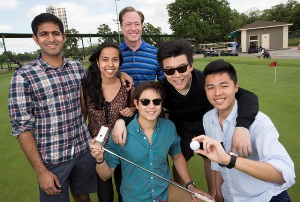Apr 21 2014
Putting is arguably the most important skill in golf; in fact, it’s been described as a game within a game. Now a team of Rice engineering students has devised a training putter that offers golfers audio, visual and tactile feedback to help them learn a consistent putting stroke.
 Team Jedi Putter. Photo by Jeff Fitlow/Rice University
Team Jedi Putter. Photo by Jeff Fitlow/Rice University
“In the past few years, some work has been done on modeling the physics of putting,” said Ray Simar, Rice professor in the practice of electrical and computer engineering who tasked five seniors with designing and creating a putter that provides multisensory feedback. “In particular, how the ball rolls, trajectories on the green and also the sweep path and how that should perform.
“I pitched the students on ‘What if we build a putter that we could drive from the perspective of the physics?’”
Working in Rice’s Oshman Engineering Design Kitchen, the students, who call themselves Team Jedi Putter, have finished a prototype and filed for a patent on a putter that has an accelerometer (to provide club speed), a gyrometer (for measuring rotation and to judge if the face of the club is twisting) and a magnetometer (to tell if the club head is up or down) all in the head of the club.
“It’s the first multisensory, real-time feedback training putter,” said Rice senior electrical engineering student Matthew Lopez. “It’s geared for beginning to intermediate golfers to help them learn a consistent putting stroke. Our main focus is not aiming on the green but rather getting consistent putts, so once you know where to aim you can hit that spot every time.” The team will address improving the golfer’s aim in an upcoming prototype.
Rice engineers create putter that gives instantaneous feedback to golfers
Simar’s original idea was for the data from the club to be downloadable after the player’s practice session; the students did that and went a step further: They designed the sensors to give real-time feedback via the grip of the putter. If a user’s club head moves up or down, doesn’t move through a straight path or twists, the sensors in the head signal vibration to the grip. The user practices with the three-dimensional sensors until they have a “clean” stroke at the ball.
“The idea is that while you’re in the motion of the putt, it will deliver audio, visual and tactile feedback to help you correct your stroke,” said Rice senior mechanical engineering student Sid Mullick. “The correct stroke is rooted in basic physics. You want to achieve a straight back-and-front stroke, a linear stroke, and you want to swing at the resonance frequency of the pendulum formed by your arms and the putter. We have all that in our algorithms, and we’re able to deliver feedback to the golfer that no other product can deliver right now.”
The practice putter can also provide data to the user though a Bluetooth-enabled device, such as their smartphone or computer, where players can analyze the data and their stroke.
Moving forward, the team plans to introduce a speaker in the head to help a user synchronize their swing to tones – much like a metronome, and they will be adding a laser in the center of the club head to assist with impacting the ball squarely. The team has also produced a “dummy” club that is designed and weighted the same as Jedi Putter but without the electronics, making it useable in real golf play.
Team Jedi Putter Rice seniors are Lopez, Mullick, Chelsea Rodrigues, Roy Wu and Yize Zhao.